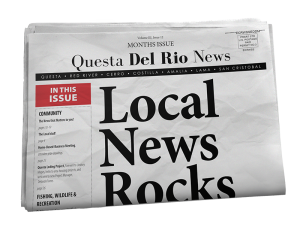The Questa Economic Development Fund (QEDF) held a meeting in collaboration with New Mexico State University’s (NMSU, Las Cruces) Arrowhead Center on prospects for an agricultural and food cooperative that would encompass northern Taos County as well as Costilla County in Colorado. Representatives from the San Luis Valley Local Foods Coalition (SLVLFC) were also in attendance.
The goal behind the agricultural co-op is to connect local farmers and ranchers together in a common and sustainable market for local food and goods, strengthening local food security.
The Arrowhead Center is a project of the NMSU for promoting entrepreneurship and strengthening small businesses.
“The hope is that the co-op meets some of the food security needs, providing greater access and opportunity for local food producers,” said Arrowhead Center Economic Development Officer Kristin Morehead.
A major drive behind regional food co-ops is concern around so-called food deserts. A food desert is an area in which residents have limited access to healthy food options or have to travel long distances for healthy food options—they typically have more impacts on economically poorer individuals. The Food Depot, a non-profit based in Santa Fe, estimates that there are about 4,850 food-insecure people throughout Taos County. “Food-insecure” describes people who lack a proper amount of food and do not know where their next meal will come from.
Morehead explained to the audience of about ten people the costs and benefits of forming this idea into a legitimate business, including the cost-benefit having a brick-and-mortar establishment to sell product, versus food producers gathering in an open space to sell products themselves. She outlined the different products that could be sold, membership fees and benefits of membership, and marketing tactics.
She emphasized five questions that should be discussed in the initial phases of a potential Questa-area food cooperative: who are you serving, what are you doing, how are you going to do it, what resources are available in your community now, and who are the people leading the charge? While Morehead continuously emphasized localism and community involvement, it seems ironic that that message is being delivered by an organization based in Las Cruces. However, that does not take away from the importance of the message.
SLVLFC Project Coordinator Jae Sanders raised an important point around cattle raising and meat production, suggesting that meat producers may be more common throughout the San Luis Valley than fruit and vegetable producers. Issues around meat production involve more strict government regulations.
“To do public retail sales, you need USDA certification,” said Sanders. “However, a private co-op or a private membership… just a handful of community members and a handful of ranchers who work among themselves… it’s not open to the public, then there’s that potential to keep it local.”
The point is to facilitate local commerce and increase people’s access to good food.
Kristin Morehead can be reached at (505) 433-1827; kmorehea@nmsu.edu.
Jae Sanders can be reached at (575) 999-5319; jae.slvlocalfoods@gmail.com.
Citations:
NMSU’s Arrowhead Center
https://arrowheadcenter.nmsu.edu
San Luis Valley Local Food Coalition
https://slvlocalfoods.org
USDA Meat Regulations
https://www.fsis.usda.gov/sites/default/files/media_file/2021-02/Fed-Food-Inspect-Requirements.pdf



